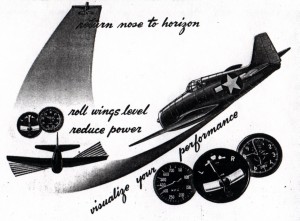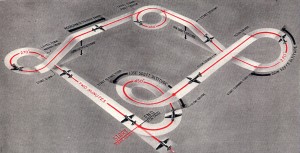By Fred “Crash” Blechman
While in Fighter Squadron Fourteen in the early 1950s, I’d just taken off in my F4U-5 Corsair towards a thin layer of low status clouds. I retracted my wheels and flaps and had set the propeller rpm, mixture control, manifold pressure and trim tabs for a nice, steady 130-knot climb. A little bumpy, but now it was just a matter of joining up on the Corsair that had just taken off ahead of me, as soon as I penetrated this supposed thin layer of clouds.
The plane ahead of me disappeared into the clouds, but I continued peering through my windscreen while climbing, hoping to spot him as soon as I climbed through. A few minutes passed in this nice steady climb, when something got my attention. The engine sounded like it was racing, and the wind past the canopy sounded like I was diving, instead of climbing!
I looked around and there was no horizon. I’d entered the clouds without realizing it, as odd as that sounds. The Corsair’s cockpit was behind the wings; when in a climb and looking straight ahead, you couldn’t see the horizon. I suddenly realized I should’ve been flying on instruments.
A glance at my instruments was shocking! A quick scan indicated I was in a left, nose-down turn, losing altitude at an airspeed of 220 knots. This couldn’t be. I was sure I was in a steady, wings-level climb. My first reaction was that the instruments were faulty.
My instruments were correct. I was in a classic “graveyard spiral,” experiencing a classic case of vertigo, and if I continued to depend on my senses, rather than my instruments, I was on the way to a fatal crash!
Fortunately, previous instrument training saved me. I reduced power, leveled my wings and then pulled back on the stick, as I added power into an instrument climb.
Unless you’ve experienced vertigo in an airplane, it’s hard to describe. When flying, you’re subject to six degrees of motion: forward, back, up, down, left and right. Simultaneously—especially in bumpy air—you’re rolling about three axes: roll, pitch and yaw.
Your human balance sensors—three semicircular canals in the inner ear, each on a different mutually-perpendicular axis—together with visual clues, provide your brain and muscles with the proper signals to keep you standing and walking without difficulty. But without visual guidance, the inner-ear senses can become confused in the flying environment and produce false signals. If you ever get into instrument flying conditions, you must learn to ignore your senses and depend on your instruments!
As long as you remain on the ground, all your senses give you clues that help maintain balance and determine direction and motion. Of all these sensations, vision is the most dominant and reliable. Many sensations are just as reliable when you fly as when you move on the ground, but others become unreliable when you’re subjected to the movements and forces of flight. Whenever you can see familiar horizontal or vertical references, you pay no attention to the other sensations, since vision dominates all others.
Sometimes, however, darkness or other conditions of poor visibility obscure familiar references. If you trust false impressions of sensations other than visual, you can become a victim of vertigo and become confused about what your airplane is doing.
You needn’t be troubled with vertigo if you learn to interpret and trust your instruments. This may be called “vision through instruments.” It’s a matter of constantly scanning your instruments and mentally interpreting their readings to provide a mental picture of the airplane’s attitude and performance.
You can’t fool around with this. You must insist that your body obey the signals provided by the instruments, with the strict adherence to the picture provided by the instruments—instead of instinct. If your senses tell you that you’re climbing, but the altimeter is dropping, the airspeed increasing and the vertical speed indicator negative, you’re not in a climb! Even if the needle-ball is centered, you could be in a dive. If you’re fortunate enough to have a gyro-horizon, that shows you your aircraft’s attitude.
Your aircraft is constantly operating under a simple formula: attitude + power = performance. Once you’ve established the airplane’s attitude by visualization of the instrument readings, you provide the necessary power for the desired performance. If your nose is up, but you’re losing airspeed, add power. If your nose is down and a wing is down, reduce power, level the wings and pull back on the stick, adding power as you approach level flight. You must force your muscles to obey your mind’s visualization, no matter how wrong it seems. If your senses get excited and out of control, the plane will follow them, and that can be fatal.

When recovering from a graveyard spiral, you must level your wings first before trying to raise the nose.
In Navy flight training, before we could fly Corsairs, we trained in the North American SNJ advanced trainers. Part of our training was flying on instruments. Initially, we spent time in single-seat Link trainers, learning to “fly blind.” We were completely enclosed as the Link trainer moved through each of its three axes, while we tried to keep the “aircraft” on a specified altitude, heading and airspeed. Then we advanced to “flying the range,” radio beams that used to be used for radio navigation. Electronic instruments that are much more reliable and far simpler to use have now replaced these.
Once schooled in the basics of Link instrument flying and mildly aware of how our senses could misdirect our actions, we climbed into the back seat of an SNJ, for an actual instrument training flight in the air. The instructors sat in the rear seat on visual flights, but for instrument training, they sat in front. After takeoff, we would pull a canvas cover over our heads and latch it to the instrument panel. While “under the hood,” our only visual clues to our plane’s attitude and performance were the instruments.
We were trained using both a “full panel” and “partial panel.” A full panel of instruments included the gyro-horizon, directional gyro, turn indicator, balance indicator (ball), altimeter, airspeed indicator, vertical speed indicator, magnetic compass, manifold pressure gage and tachometer. A partial panel meant the gyro-horizon and directional gyro were either caged or covered.
After learning to fly straight and level with standard turns, climbs and descents, the instructor would put the plane in an unusual attitude, possibly even inverted! We had to pull it out, while under the hood! That’s when we discovered that confusion in interpreting the instruments caused vertigo—and that in real life situations, we must depend on our instruments.
ABLE, BAKER and CHARLIE
Various imaginary patterns were used in instrument training, initially practiced in the Link, then in the air. The ABLE pattern was the simplest: maintain cruising speed and altitude, fly north for one minute, then make a 90-degree right turn, at the standard three-degrees-per-second turn rate. Repeat this for three more legs, ending up where you started, six minutes after you began. Even this simple two-dimensional pattern took practice while under the hood.
The BAKER pattern was a bit more elaborate, but still only two-dimensional. There were no changes in altitude. All turns were at the standard three-degrees-per-second rate. Maintain cruising speed and altitude, fly north for two minutes, 270-degree left turn, two minutes, 450-degree right turn, two minutes, 270-degree left turn, two minutes, then final 450-degree right turn to end up where you started, 16 minutes later.
The really tough one was the CHARLIE pattern. This involved a pattern similar to the BAKER pattern, but with various changes in altitude at the rate of 500 feet per minute—sometimes even when turning—and changes in airspeed. Turns were still at the rate of three degrees per second. The ten-step pattern went this way, with all straight legs two minutes long: start heading north at normal cruise speed; two minutes straight and level; level 270-degree left turn; climb, gaining 500 feet and then accelerate to fast cruise; level 450-degree right turn; level one minute, lose 500 feet in second minute; climbing 270-degree left turn, gaining 500 feet; slow cruise two minutes; descending 450-degree right turn, losing 500 feet; end 16 minutes from start, in slow cruise.
Whew! This was a real workout, but it was great training for the fleet, where it wasn’t uncommon for us to fly under instrument conditions.
When I got into advanced training flying Corsairs, the instrument training was somewhat different, since this was a single-cockpit airplane. The pilot in training used a hood that slipped over his helmet and obstructed the view through the canopy. Another plane flew nearby as a safety pilot—to be sure the trainee didn’t get into a dangerous flight condition and to make sure interfering aircraft weren’t nearby. Typically, two planes would go up and “switch” flying instruments, communicating by radio.
We could practice flying the radio ranges that existed in those days. These consisted of four radio beams emanating from a stationary site, dividing the area into four quadrants. Alternate quadrants had a Morse code “A” or “N,” and the “beam” would be a steady signal, since it combined the “dit-dah” of the “A” signal with the “dah-dit” of the “N” signal.
A series of Morse code letters would identify the station. Standard turning procedures were used to determine which quadrant you entered and whether you were flying toward or away from the station. When you were in the immediate vicinity of the station, you would enter the “cone of silence” as you flew by.
Another thing we practiced (although I only recall doing this in the fleet, while in VF-14, and not in flight training) was flying ground-controlled approach. Here, again, under the hood and with a safety plane alongside, you flew a verbal approach to a runway. Ground controllers would have you on radar that defined your altitude (above or below) and your position (left or right) of an imaginary glide path that ended near the approach end of the runway. You flew instruments as the controller would announce your condition: “Above glide path…turn three degrees left…on glide path…on heading…below glide path…add power…turn right five degrees…coming up nicely…on glide path…on heading…” etc. Some would be more specific, like “Twenty feet above glide path…” In any case, you did the best you could to stay on heading, on glide path, and at about 100 feet (or was it 200 feet?) above the runway level, you’d pop the hood and spot the runway for a visual landing. GCA didn’t take you to touchdown.
I always found instrument flying in the Link trainers challenging and a lot of fun. In a way, it was like playing with a pinball machine—trying to get the ball and all the needles and gauges to do what you wanted them to do. In the real world, however, if you didn’t trust your instruments when you lost outside visual, you were a dead man!
Since 1961, Fred “Crash” Blechman has written more than 1,100 magazine articles and eight books about electronics, microcomputers and flying. His two flying books, “Bent Wings – F4U Corsair Action & Accidents: True Tales of Trial & Terror!” and “Flying With the Fred Baron,” are available at [http://www.amazon.com].You may contact him at crash@airportjournals.com












